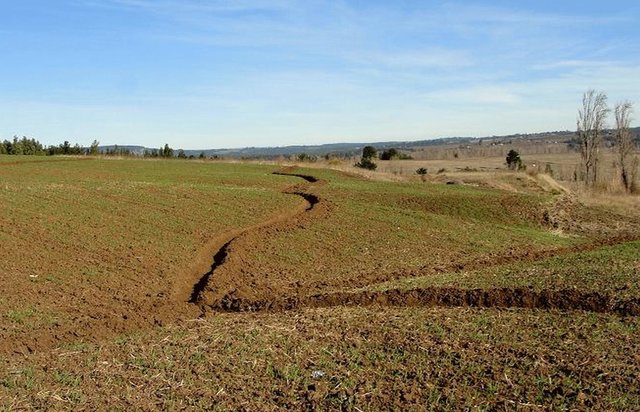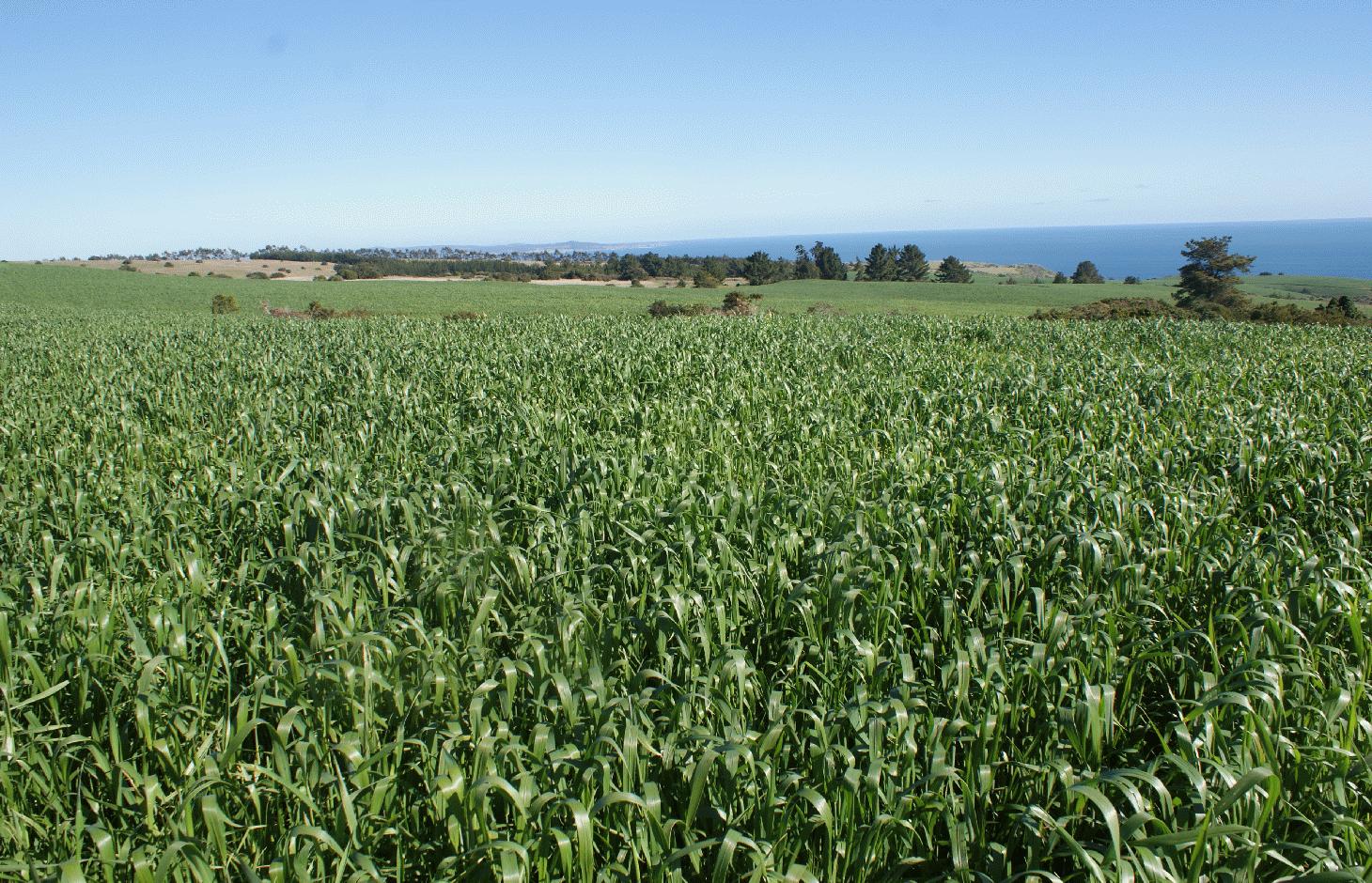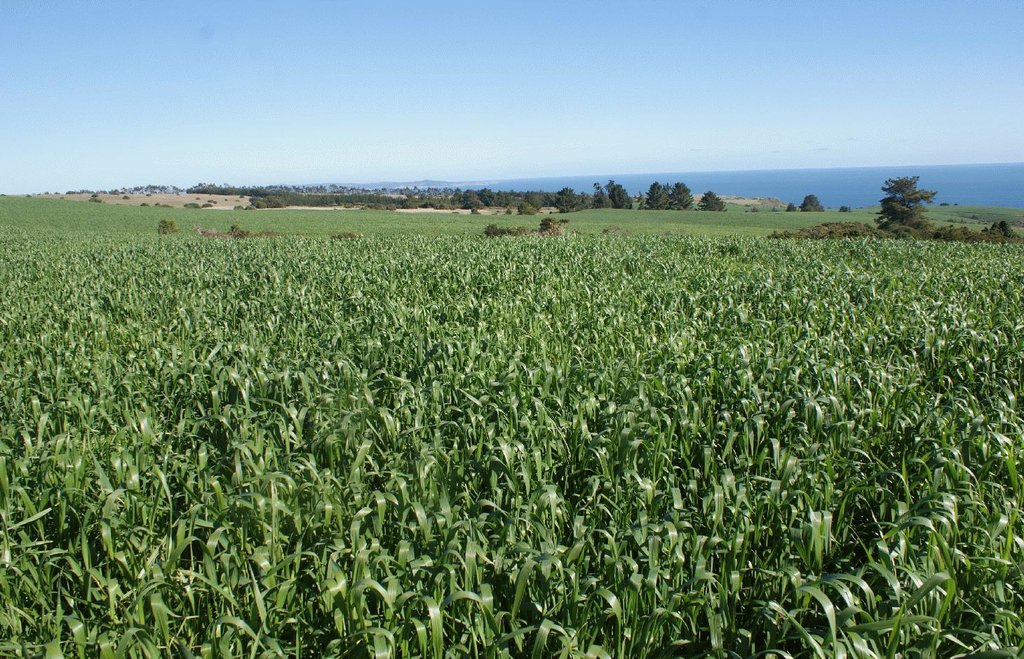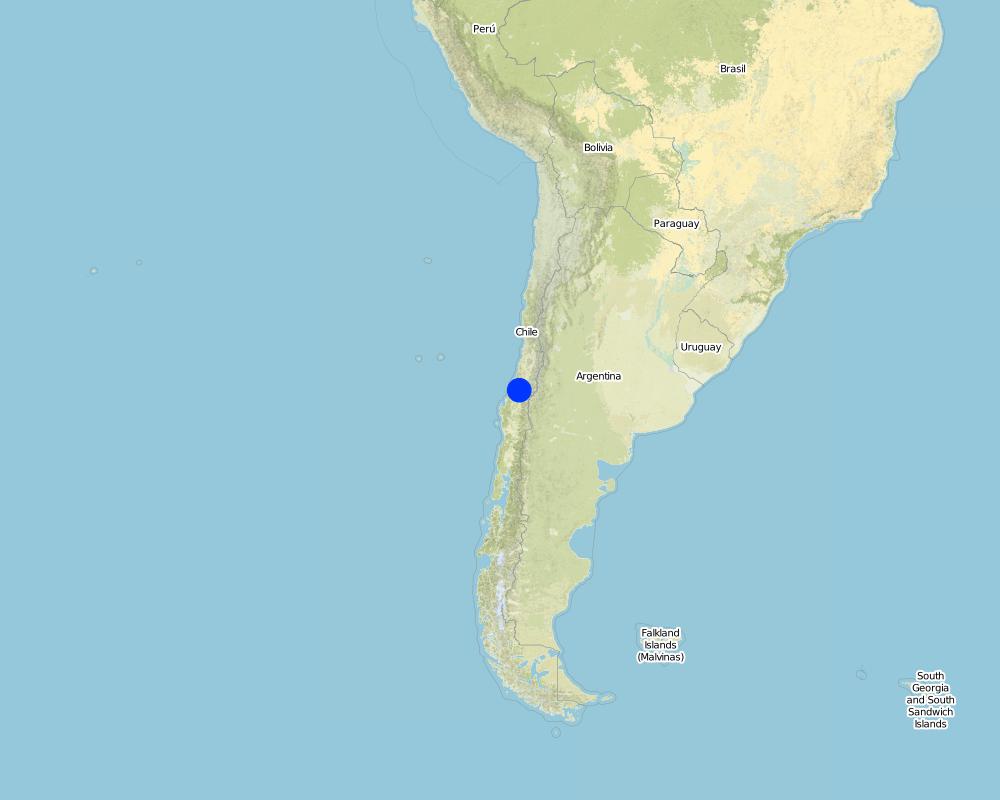Crop rotation with legumes [تشيلي]
- تاريخ الإنشاء:
- تحديث:
- جامع المعلومات: Carlos Ovalle
- المحرر: –
- المراجعون: Deborah Niggli, Alexandra Gavilano
Rotación de cultivos con leguminosas (Spanish)
technologies_1123 - تشيلي
عرض الأقسام
توسيع الكل طي الكل1. معلومات عامة
1.2 تفاصيل الاتصال بالأشخاص الرئيسيين لمصدر المعلومات والمؤسسات المشاركة في تقييم وتوثيق التقنية
متخصص في الإدارة المستدامة للأراضي:
Soledad Espinoza
Instituto de Investigaciones Agropecuarias
تشيلي
اسم المشروع الذي سهّل توثيق/تقييم التقنية (إذا كان ذلك على صلة)
DESIRE (EU-DES!RE)اسم المؤسسة (المؤسسات) التي سهلت توثيق/تقييم التقنية (إذا كان ذلك على صلة)
Instituto de Investigaciones Agropecuarias (INIA) (Instituto de Investigaciones Agropecuarias (INIA)) - تشيلي1.3 الشروط المتعلقة باستخدام البيانات الموثقة من خلال WOCAT
يوافق جامع المعلومات والشخص (لاشخاص) الرئيسي لمصدر المعلومات على الشروط المتعلقة باستخدام البيانات الموثقة من خلال WOCAT:
نعم
1.5 الإشارة إلى الاستبيان (الاستبيانات) حول مناهج الإدارة المستدامة للأراضي (موثقة باستخدام WOCAT)

Dissemination of soil conservation technologies in dryland areas [تشيلي]
Dissemination of no tillage with subsoiling in the Municipality of Yumbel
- جامع المعلومات: Carlos Ovalle
2. وصف تقنيةالإدارة المستدامي للأراضي
2.1 وصف مختصر للتقنية
تعريف التقنية:
Biological Nitrogen Fixation (BNF) of legumes as a source of N in crop rotations with cereals in Mediterranean Chile
2.2 وصف تفصيلي للتقنية
الوصف:
In the past, legumes were commonly used as a biological and economic source of N for farming systems. Nowadays, N-fixing legumes have been recovering as viable crops because of the increased cost of N fertilizer and the need to develop more sustainable farming systems.
Purpose of the Technology: These systems combine phases of legumes of different duration, in which N is fixed and accumulates in the soil, followed by phases of cereal growing during which accumulated N is extracted
Establishment / maintenance activities and inputs: In this new rotation for rainfed agricultural systems in Central Chile, four legume-wheat rotations were compared to a monoculture crop rotation (wheat followed by oat). The legume species are: the narrow-leaf lupin (Lupinus angustifolium); Wonga (early-flowering and high-yielding narrow-leafed lupin variety), yellow lupin (Lupinus luteus); Motiv, Peas (Pisum sativum); Rocket and a fodder mixture of vetch (Vicia atropurpurea) with oats. Legume seeds were inoculated with a specific Rhizobium. In the year following the legume crop, wheat was seeded without N fertilisation on the incorporated residues of grain legumes and green manure (vetch with oats). The BNF in the grain legumes varies from 124 to 178 kg N ha-1, depending on the type of legume. Peas are the most efficient fixing legume crop. In the lupins - wheat (L. angustifolius) rotation without application of N to the wheat after lupins, production of wheat was between 79 and 110% of that when fertilised with N. In the peas - wheat rotation, a yield equivalent to 72 and 105% of the wheat fully fertilised with N was obtained. While peas (Pisum sativum) can be eaten as a green vegetable, lupins and Vicia are used as fodder supplements for animals.
Natural / human environment: The new rotations were developed and evaluated experimentally. Then, through a technology transfer programme, the technology was transferred to real conditions with farmers in a programme covering 250 ha in the municipality of Yumbel.
The area has a subhumid Mediterranean climate with an average annual precipitation of 695 mm (80% concentrated in winter), with five months of drought. Soils are Alfisols of the Cauquenes type, classified as Ultic Palexeralfs. The soil is formed from weathered granite with moderately acidic conditions and low organic carbon. Clay content in the soil is 15% at depths of 0-18 cm depth. Below this depth, it is above 44%. The topography comprises a hillslope with a gradient of 10-20 % and the main traditional crop rotation is oat-wheat or wheat-natural pasture. The farmers are smallholders working on their own land. The sizes of the holdings on the dryland soils vary from 5 to 20 ha.
2.3 صور التقنية
2.5 البلد/المنطقة/المواقع التي تم تنفيذ التقنية فيها والتي يغطيها هذا التقييم
البلد:
تشيلي
المنطقة/الولاية/المحافظة:
Cauquenes and Bíobio
مزيد من التفاصيل حول الموقع:
Secano interior, Mediterranean Chile
حدد انتشار التقنية:
- منتشرة بالتساوي على مساحة
إذا كانت التقنيةا موزعة بالتساوي على منطقة ما، حدد المساحة المغطاة (بالكيلومتر المربع):
250,0
التعليقات:
Total area covered by the SLM Technology is 250 km2
Map
×2.6 تاريخ التنفيذ
في حالة عدم معرفة السنة بالتحديد، يرجى الإشارة إلى التاريخ التقريبي:
- منذ أقل من 10 سنوات (مؤخرًا)
2.7 إدخال التقنية
حدد كيف تم إدخال التقنية:
- أثناء التجارب/الأبحاث
- من خلال المشاريع/ التدخلات الخارجية
3. تصنيف تقنية الإدارة المستدامي للأراضي
3.1 الغرض الرئيسي ( الأغراض الرئيسية) للتقنية
- الحفاظ على النظام البيئي
3.2 نوع (أنواع) استخدام الأراضي الحالية حيث يتم تطبيق التقنية

الأراضي الزراعية
- زراعة سنوية
الزراعة السنوية - حدد المحاصيل:
- الحبوب - الشوفان
- الحبوب البقولية والبقول - أخرى
- الحبوب البقولية والبقول- البازلاء
- الخضروات - الخضروات الورقية (السلطات، الملفوف، السبانخ، وغيرها)
- wheat
حدد:
Longest growing period in days: 180; Longest growing period from month to month: Mar - Nov
هل تتم ممارسة تناوب المحاصيل؟:
نعم
التعليقات:
The legume species are: the narrow-leaf lupin (Lupinus angustifolium); Wonga (early-flowering and high-yielding narrow-leafed lupin variety), yellow lupin (Lupinus luteus); Motiv, Peas (Pisum sativum); Rocket and a fodder mixture of vetch (Vicia atropurpurea) with oats
Major land use problems (compiler’s opinion): In rainfed areas of the Mediterranean region of Chile, bread wheat (Triticum aestivum) is mainly produced in rotation with oats (Avena sativa) and therefore N is obtained from the soil and synthetic N fertilizers applied during sowing and ploughing. These intensive crop rotations have resulted in deterioration of the physical properties and a depletion of soil fertility as a result of the drastic reduction in organic matter content of these soils.
3.5 مجموعةالإدارة المستدامة للأراضي التي تنتمي إليها هذه التقنية
- أنظمة التناوب (تعاقب المحاصيل، البور، الزراعة المتنقلة)
3.6 التدابير التقنية في مجال إلادارة المستدامة للأراضي

التدابير الزراعية
- A1: الغطاء النباتي/التربة
3.7 الأنواع الرئيسية من تدهور الأراضي التي تناولتها التقنية

التدهور الكيميائي للتربة
- (Cn): تراجع الخصوبة وانخفاض محتوى المادة العضوية (غير ناتج عن الانجراف)
التعليقات:
Main type of degradation addressed: Cn: fertility decline and reduced organic matter content
Main causes of degradation: soil management, change in temperature, change of seasonal rainfall, Heavy / extreme rainfall (intensity/amounts), education, access to knowledge and support services
3.8 منع أو حد أو عكس تدهور الأراضي
تحديد هدف التقنية فيما يتعلق بتدهور الأراضي:
- منع تدهور الأراضي
- الحد من تدهور الأراضي
4. المواصفات الفنية، وأنشطة التنفيذ، والمدخلات، والتكاليف
4.1 الرسم الفني للتقنية
المواصفات الفنية (المتعلقة بالرسم الفني):
Lupins forming part of the crop sequence (Lupinus angustifolium)
Technical knowledge required for land users: high
Main technical functions: increase in organic matter, increase in nutrient availability (supply, recycling,…), promotion of new crops and varieties
Secondary technical functions: improvement of ground cover
المؤلف:
Soledad Espinoza
4.2 معلومات عامة بخصوص حساب المدخلات والتكاليف
حدد العملة المستخدمة لحساب التكاليف:
- دولار أمريكي USD
4.5 الصيانة/الأنشطة المتكررة
| النشاط | التوقيت/الوتيرة | |
|---|---|---|
| 1. | Seeding legumes | |
| 2. | Application of fertilizer | |
| 3. | Harvesting with special machinery |
4.6 التكاليف والمدخلات اللازمة للصيانة/للأنشطة المتكررة (سنويًا)
| تحديد المدخلات | الوحدة | الكمية | التكاليف لكل وحدة | إجمالي التكاليف لكل مدخل | % من التكاليف التي يتحملها مستخدمو الأراضي | |
|---|---|---|---|---|---|---|
| العمالة | Seed, fertilize and harvest | ha | 1,0 | 146,0 | 146,0 | 100,0 |
| معدات | Rent seeder machine+harvesting | ha | 1,0 | 293,0 | 293,0 | 60,0 |
| المواد النباتية | Seeds | ha | 1,0 | 306,0 | 306,0 | 80,0 |
| إجمالي تكاليف صيانة التقنية | 745,0 | |||||
| إجمالي تكاليف صيانة التقنية بالدولار الأمريكي | 745,0 | |||||
4.7 أهم العوامل المؤثرة على التكاليف
قدم وصفا لأهم العوامل التي تؤثر على التكاليف:
There are not establishment inputs and costs because in annual crops all the cost are recurrent
5. البيئة الطبيعية والبشرية
5.1 المناخ
هطول الأمطار السنوي
- < 250 مم
- 251- 500 ملم
- 501 - 750ملم
- 1,000-751 ملم
- 1,500-1,100 ملم
- 2,000-1,500 ملم
- 3,000-2,001 ملم
- 4,000-3,100 ملم
- > 4000 ملم
المنطقة المناخية الزراعية
- شبه رطبة
Thermal climate class: temperate
5.2 طوبوغرافيا
متوسط الانحدارات:
- مسطح (0-2%)
- بسيط (3-5%)
- معتدل (6-10%)
- متدحرج (11-15%)
- تلال (16-30%)
- شديدة الانحدار(31-60%)
- فائقة الانحدار (>60%)
التضاريس:
- هضاب/سهول
- أثلام مرتفعة
- المنحدرات الجبلية
- منحدرات التلال
- منحدرات في السفوح
- قاع الوادي
المنطقة الارتفاعية:
- 100-0 متر فوق سطح البحر
- 500-101 متر فوق سطح البحر
- 1,000-501 متر فوق سطح البحر
- 1,500-1,001 متر فوق سطح البحر
- 2,000-1,501 متر فوق سطح البحر
- 2,500-2,100 متر فوق سطح البحر
- 3,000-2,501 متر فوق سطح البحر
- 4,000-3,001 متر فوق سطح البحر
- > 4000 متر فوق سطح البحر
التعليقات والمواصفات الإضافية بشأن التضاريس:
Slopes on average: Also hilly
5.3 التربة
متوسط عمق التربة:
- ضحل جدًا (0-20 سم)
- ضحلة (21-50 سم)
- متوسطة العمق (51-80 سم)
- عميقة (81-120 سم)
- عميقة جدًا (> 120 سم)
قوام التربة (التربة السطحية):
- ناعم/ثقيل (طيني)
المواد العضوية في التربة السطحية:
- منخفضة (<1%)
إذا كان متاحًا، قم بإرفاق وصف كامل للتربة أو تحديد المعلومات المتوفرة، على سبيل المثال نوع التربة، الرقم الهيدروجيني/ درجة حموضة التربة، قدرة التبادل الكاتيوني، النيتروجين، الملوحة وما إلى ذلك.
Soil fertility is very low
Soil drainage / infiltration is poor
Soil water storage capacity is very low
5.4 توافر المياه ونوعيتها
منسوب المياه الجوفية:
50-5 م
توافر المياه السطحية:
ضعيف/ غير متوافر
نوعية المياه (غير المعالجة):
مياه شرب جيدة
5.5 التنوع البيولوجي
تنوع الأنواع:
- منخفض
5.6 خصائص مستخدمي الأراضي الذين يطبقون التقنية
التوجه السوقي لنظام الإنتاج:
- مختلط (كفاف/ تجاري)
الدخل من خارج المزرعة:
- >50% من إجمالي الدخل
المستوى النسبي للثروة:
- ضعيف
أفراداً أو مجموعات:
- فرد/أسرة معيشية
الجنس:
- رجال
اذكر الخصائص الأخرى ذات الصلة لمستخدمي الأراضي:
Population density: 10-50 persons/km2
Annual population growth: < 0.5%
80% of the land users are poor and own 60% of the land.
5.7 متوسط مساحة الأرض التي يستخدمها مستخدمو الأراضي الذين يطبقون التقنية
- < 0.5 هكتارا
- 0.5 - 1 هكتار
- 1 -2 هكتار
- 2 - 5 هكتار
- 5 - 15 هكتار
- 15 - 50 هكتار
- 50 - 100هكتار
- 500-100 هكتار
- 1,000-500 هكتار
- 10,000-1,000 هكتار
- > 10,000 هكتار
5.8 ملكية الأراضي، وحقوق استخدام الأراضي، وحقوق استخدام المياه
ملكية الارض:
- فردية، لا يوجد سند ملكية
حقوق استخدام الأراضي:
- فردي
حقوق استخدام المياه:
- فردي
5.9 الوصول إلى الخدمات والبنية التحتية
الصحة:
- ضعيف
- معتدل
- جيد
المساعدة التقنية:
- ضعيف
- معتدل
- جيد
العمل (على سبيل المثال خارج المزرعة):
- ضعيف
- معتدل
- جيد
الطاقة:
- ضعيف
- معتدل
- جيد
الطرق والنقل:
- ضعيف
- معتدل
- جيد
مياه الشرب وخدمات الصرف الصحي:
- ضعيف
- معتدل
- جيد
6. الآثار والتصريحات الختامية
6.1 الآثار التي أظهرتها التقنية في الموقع
الآثار الاجتماعية والاقتصادية
الإنتاج
إنتاج المحاصيل
إنتاج الأعلاف
جودة العلف
خطر فشل الإنتاج
تنوع المنتج
الدخل والتكاليف
دخل المزرعة
تنوع مصادر الدخل
عبء العمل
الآثار الاجتماعية والثقافية
الأمن الغذائي / الاكتفاء الذاتي
الوضع الصحي
المعرفة بالإدارة المستدامة للأراضي/تدهور الأراضي
livelihood and human well-being
الآثار الايكولوجية
التربة
غطاء التربة
فقدان التربة
تكون قشرة التربة السطحية/انسداد مسام التربة
دورة المغذيات/إعادة الشحن
المادة العضوية في التربة/تحت الطبقة c
التنوع البيولوجي: الغطاء النباتي، الحيوانات
الكتلة الحيوية/ طبقة الكربون فوق التربة
الآثار الايكولوجية الأخرى
hazard towards adverse events
6.2 الآثار التي أظهرتها التقنية خارج الموقع
توافر المياه
surface runoff
6.3 تعرض التقنية وحساسيتها لتغير المناخ التدريجي والظواهر المتطرفة/الكوارث المرتبطة بالمناخ (كما يراها مستخدمو الأراضي)
تغير مناخ تدريجي
تغير مناخ تدريجي
| الموسم | زيادة أو نقصان | كيف تتعامل التقنية مع ذلك؟ | |
|---|---|---|---|
| درجة الحرارة السنوية | زيادة | جيدا |
الظواهر المتطرفة / الكوارث المرتبطة بالمناخ
الكوارث المناخية
| كيف تتعامل التقنية مع ذلك؟ | |
|---|---|
| جفاف | ليس جيدا |
التعليقات:
This technology should be complemented with no tillage and subsoiling of the soil (see QT CHL01).
6.4 تحليل التكلفة والعائد
كيف يمكن مقارنة العوائد نسبة لتكاليف الإنشاء (من وجهة نظر مستخدمي الأراضي)؟
عوائد قصيرة الأجل:
إيجابي
عوائد طويلة الأجل:
إيجابي
كيف تتم مقارنة العوائدمع كلفة الصيانة/التكاليف المتكررة (من وجهة نظر مستخدمي الأراضي)؟
عوائد قصيرة الأجل:
إيجابي
عوائد طويلة الأجل:
إيجابي
6.5 اعتماد التقنية
التعليقات:
Comments on acceptance with external material support: This is a new approach to the cereal production system in rainfed areas. Initially the adoption has been slow, as the results obtained in the project are recent.
Comments on adoption trend: . Hence it is expected that in the future the adoption of this technology increases up to 20,000 ha in the “secano interior” of south-central Chile
6.7 نقاط القوة / المزايا / الفرص التي توفرها التقنية
| نقاط القوة/ المزايا/ الفرص من وجهة نظر جامع المعلومات أو غيره من الاشخاص الرئيسيين لمصدر المعلومات |
|---|
|
Reduces the costs of fertiliser: the incorporation of legumes in the rotation cycle means a saving of 30% of nitrogen fertilizer in cereal production costs How can they be sustained / enhanced? keep the phases of legumes sufficiently frequent and long |
| Increases the economic benefits. When analysing the whole farming system, replacing the traditional rotation of wheat followed by natural pasture, implies two economic benefits for the producer: increasing the income by the incorporation of a new crop (legumes) and the reduction of costs in the fertilization of cereals. |
|
Increase soil organic matter: the new rotation system means a new concept in the management of crop residues. These should be incorporated into the soil, which in the medium and long term will involve an increase in the soil organic matter content How can they be sustained / enhanced? ensure application of the new management of crop residues |
| The new rotation system involves an increase in productivity of the land, as it incorporates new cultures and improves the physical and chemical conditions of the soils. |
6.8 نقاط ضعف / مساوىء / مخاطر التقنية وسبل التغلب عليها
| نقاط الضعف/ المساوىء/ المخاطر من وجهة نظر جامع المعلومات أو غيره من الاشخاص الرئيسيين لمصدر المعلومات | كيف يمكن التغلب عليها؟ |
|---|---|
| Necessity of more training for the farmers | improve / enhance agricultural extension |
7. المراجع والروابط
7.1 طرق جمع/مصادر المعلومات
7.2 المراجع للمنشورات المتاحة
العنوان، المؤلف، السنة، النظام القياسي الدولي لترقيم الكتب ISBN:
Espinoza, S., Ovalle, C., del Pozo, A., Zagal, E., Urquiaga, S. 2011. Biological Fixation of N2 in mono and polyspecific legume pasture in the humid Mediterranean zone of Chile. Chilean Journal of Agricultural Research. 71(1):132-139.
الروابط والوحدات المواضيعية
توسيع الكل طي الكلالروابط

Dissemination of soil conservation technologies in dryland areas [تشيلي]
Dissemination of no tillage with subsoiling in the Municipality of Yumbel
- جامع المعلومات: Carlos Ovalle
الوحدات المواضيعية
لا يوجد وحدات مواضيعية






